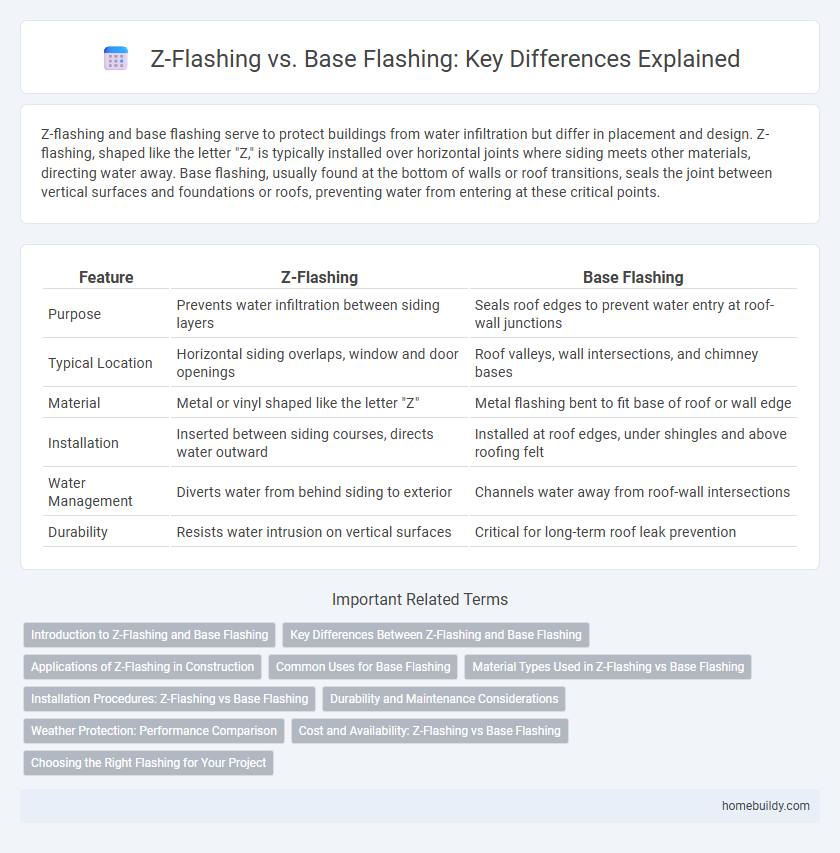Z-flashing and base flashing serve to protect buildings from water infiltration but differ in placement and design. Z-flashing, shaped like the letter "Z," is typically installed over horizontal joints where siding meets other materials, directing water away. Base flashing, usually found at the bottom of walls or roof transitions, seals the joint between vertical surfaces and foundations or roofs, preventing water from entering at these critical points.
Table of Comparison
| Feature | Z-Flashing | Base Flashing |
|---|---|---|
| Purpose | Prevents water infiltration between siding layers | Seals roof edges to prevent water entry at roof-wall junctions |
| Typical Location | Horizontal siding overlaps, window and door openings | Roof valleys, wall intersections, and chimney bases |
| Material | Metal or vinyl shaped like the letter "Z" | Metal flashing bent to fit base of roof or wall edge |
| Installation | Inserted between siding courses, directs water outward | Installed at roof edges, under shingles and above roofing felt |
| Water Management | Diverts water from behind siding to exterior | Channels water away from roof-wall intersections |
| Durability | Resists water intrusion on vertical surfaces | Critical for long-term roof leak prevention |
Introduction to Z-Flashing and Base Flashing
Z-flashing and base flashing are essential components in preventing water infiltration in building envelopes, particularly around windows and doors. Z-flashing is a metal flashing bent into a Z shape, designed to direct water away from the wall, whereas base flashing is installed at the bottom edge of a wall or roof intersection to provide a moisture barrier. Understanding the correct application of Z-flashing versus base flashing ensures enhanced durability and protection against leaks in construction projects.
Key Differences Between Z-Flashing and Base Flashing
Z-flashing is installed primarily to prevent water infiltration at horizontal siding joints, featuring an overlapping Z-shaped profile that directs water away from the wall assembly. Base flashing is used at the intersection between roofing materials and vertical walls or chimneys, creating a waterproof barrier to channel water off the roof. The key differences lie in their application areas and design: Z-flashing safeguards siding horizontal seams, while base flashing protects roof-to-wall junctions against moisture intrusion.
Applications of Z-Flashing in Construction
Z-flashing is commonly applied in construction to protect wall assemblies from water infiltration by diverting moisture away from joints where different materials meet, such as between siding and window or door openings. It is especially effective in horizontal laps, window heads, and transitions between masonry and wood framing, ensuring enhanced water resistance and durability. Unlike base flashing, which is primarily installed at the foundation-wall interface, Z-flashing addresses moisture control in above-grade installations to prevent damage and improve the building envelope's performance.
Common Uses for Base Flashing
Base flashing is commonly installed at roof-to-wall intersections, chimneys, and parapet walls to create a watertight barrier against moisture penetration. It serves as a foundational layer that directs water away from vulnerable joints and surfaces, preventing leaks and structural damage. Unlike Z-flashing, base flashing is integral in areas requiring a seamless connection between roofing materials and vertical structures.
Material Types Used in Z-Flashing vs Base Flashing
Z-flashing typically utilizes flexible materials like rubberized asphalt or vinyl, designed to create a durable barrier that channels water away from edges and joints. Base flashing often employs metal components such as aluminum or galvanized steel, chosen for their rigidity and long-lasting protection against moisture intrusion at roof-to-wall junctions. The selection of materials in Z-flashing versus base flashing directly impacts their effectiveness in different weather conditions and architectural applications.
Installation Procedures: Z-Flashing vs Base Flashing
Z-flashing installation involves securing an interlocking metal strip over vertical siding edges to direct water away and prevent infiltration, typically nailed into the wall sheathing and integrated with house wrap. Base flashing is installed at horizontal or lower roof-wall intersections, often under the roofing material and extended onto the wall surface to channel water outward, requiring precise layering with roofing underlayment to ensure waterproofing. Both methods demand careful alignment and sealing, but Z-flashing primarily protects vertical joints while base flashing addresses horizontal transitions in roofing systems.
Durability and Maintenance Considerations
Z-flashing offers superior durability compared to base flashing due to its design that effectively directs water away from vulnerable joints, reducing the risk of moisture infiltration and structural damage. Its installation requires careful maintenance to ensure the flashing remains securely fastened and free from corrosion, which can compromise its protective function over time. Regular inspection and timely repairs are crucial for both Z-flashing and base flashing to maintain optimal water resistance and prolong the lifespan of building exteriors.
Weather Protection: Performance Comparison
Z-flashing offers superior weather protection by effectively directing water away from critical joints, minimizing the risk of water infiltration compared to base flashing. Its shape creates a more efficient barrier against wind-driven rain and moisture penetration, enhancing the durability of exterior walls. Base flashing, while functional, often relies on overlapping materials which can be less effective under heavy exposure to harsh weather conditions.
Cost and Availability: Z-Flashing vs Base Flashing
Z-flashing typically costs more than base flashing due to its intricate installation process and the use of specialized materials designed for enhanced water resistance. Availability of Z-flashing can be limited in certain regions, requiring ordering from specialty suppliers, whereas base flashing is widely accessible and commonly stocked by most building material retailers. Homeowners and contractors often choose base flashing for cost efficiency and ease of procurement, while Z-flashing remains preferred for high-end applications demanding superior moisture protection.
Choosing the Right Flashing for Your Project
Z-flashing provides superior water diversion for siding installations by creating a robust barrier against moisture infiltration, making it ideal for wood, vinyl, and fiber cement siding projects. Base flashing, typically used at roof-to-wall intersections, offers critical protection where horizontal surfaces meet, preventing water penetration at vulnerable joints. Selecting the right flashing depends on the specific application and exposure to weather elements, ensuring long-term durability and effective moisture management.
Z-flashing vs base flashing Infographic

 homebuildy.com
homebuildy.com